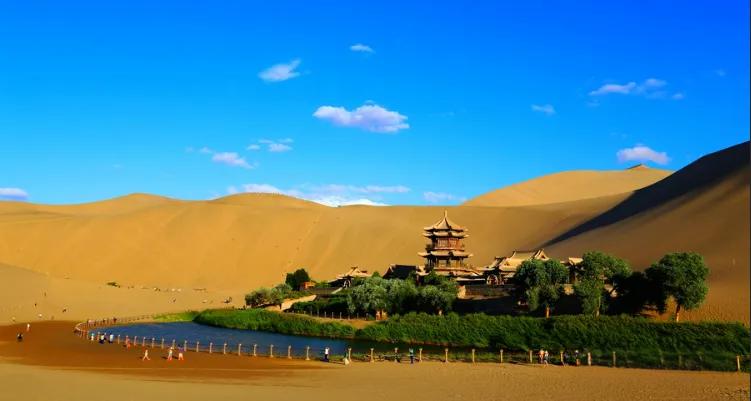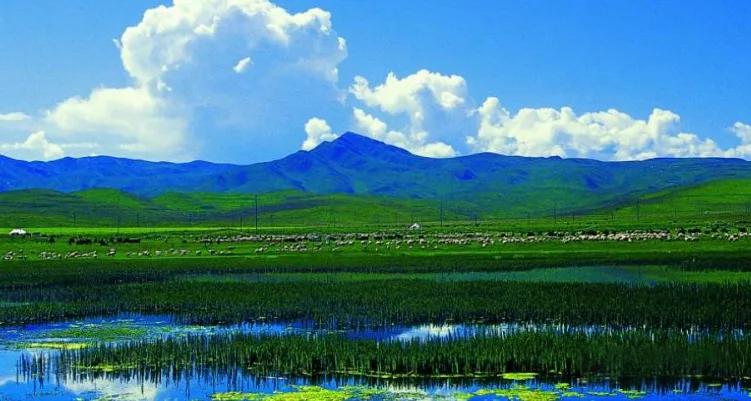1.Kongtong Mountain

Kongtong Mountain Scenic Area, located in Kongtong Ancient Town, Pingliang City, Gansu Province, is an important birthplace and holy place of Taoism. It is also one of the most famous mountains in Northwest China and a fortress on the west exit of the ancient Silk Road. Since ancient times, it has been known as “the first mountain in the west”, “the wonder of the west town”, “the most beautiful mountain in the world”, “the most majestic and beautiful in the pass”, and “the source of Taoism”. The Taoist tradition of Kongtong Mountain has a long history. The story of Huangdi asking Guangchengzi for Taoism in the classical legend took place here.
2.Mingsha Mountain Crescent Lake

Mingsha Mountain and Crescent Lake Scenic Spot are located in Dunhuang City, Gansu Province. Mingsha Mountain is famous for its loud sand movement. This mountain is formed by quicksand and has five colors: red, yellow, green, white and black. Crescent Lake is surrounded by Mingsha Mountain and is named after its shape that resembles a crescent moon. The sand flowing down from the mountains around Crescent Lake is sent back to the other side of the Mingsha Mountain ridge on all sides, which is why the spring water is not covered by yellow sand.
3.Colorful Danxia

The Colorful Danxia Scenic Area, located in Linze County and Sunan County of Zhangye City, Gansu Province, is known as the first colorful hill in China. It is one of the areas with the largest and best developed Danxia landforms and the richest landforms in my country. The Colorful Mountain is famous for its alternating layers, steep cliffs, majestic momentum, rich shapes and colorful colors. There are wonderful landscapes such as the Colorful Gorge, Colorful Tower, Colorful Screen, Colorful Silk, Colorful Lake, Colorful Scallop, Sea of Fire, and Knife Mountain.
4.Guanegou

Guanegou National Forest Park, located in Dangchang County, Longnan City, Gansu Province, is a canyon about 30 kilometers long. There are more than 20 emerald green lakes of different shades in the canyon. The mountains on both sides of the canyon are steep, and there are many waterfalls cascading down the cliffs.
5.Maiji Mountain

Maijishan Scenic Area, located in Tianshui City, Gansu Province, consists of five scenic areas: Maijishan Grottoes, Xianren Cliff, Shimen, Quxi, and Jieting Hot Spring. Maijishan Grottoes, located on steep cliffs and surrounded by green plants, is the main attraction of the scenic area and one of the most famous grottoes in Northwest China. Maijishan Grottoes, together with Dunhuang Mogao Grottoes, Datong Yungang Grottoes, and Luoyang Longmen Grottoes, are known as the four major grottoes in China.
6.Bingling Temple

Bingling Temple is a world cultural heritage tourist area, located in Xiaojishishan Mountain, 35 kilometers southwest of Yongjing County, Linxia Hui Autonomous Prefecture, Gansu Province. It consists of three major areas: Bingling Lake, Bingling Stone Forest, and Bingling Temple Grottoes in Bingling Stone Forest. Bingling Lake is the reservoir of Liujiaxia Hydropower Station, the first large-scale hydropower station of one million kilowatts in Asia. It is the famous “Blue Yellow River, the Sea of Gansu”. Bingling Stone Forest is a Danxia landform formed by the accumulation of purple-red fine sandstone in the early Cretaceous period of the Cenozoic Era. Bingling Temple Grottoes was successfully included in the World Heritage List as a site jointly applied for by China, Kazakhstan and Kyrgyzstan.
7.Mogao Grottoes

Dunhuang Mogao Grottoes, located in Dunhuang City, Gansu Province, is one of the four famous grottoes in my country. Mogao Grottoes is about 1,600 meters long from north to south, with five layers arranged up and down, high and low in a staggered manner, lined up in rows, shaped like a beehive and pigeon house, and is extremely spectacular. It is the largest and most content-rich treasure house of classical culture and art in my country, and is also a world-famous Buddhist art center.
8.Jiayuguan

Jiayuguan, located in Jiayuguan City, Gansu Province, is the western section of the Ming Great Wall. Due to its rugged terrain and magnificent architecture, it is known as “the most majestic pass in the world” and “the key to connecting the frontiers”. It is a transportation fortress on the ancient “Silk Road”. It is one of the three wonders of the Great Wall of China. It was built in the Ming Dynasty and is the most spectacular pass along the Ming Great Wall. The main attractions include Jiayuguan Pass, the Hanging Wall Great Wall, the First Pier of the Great Wall, the Wei and Jin Tombs, the Black Mountain Stone Carvings, the Mulan City, the “July 1” Glacier, the Gliding Base, etc.
9.Jinta Desert Poplar Forest

The Jinta Desert Poplar Forest Scenic Area is located in Jinta County, Jiuquan City, Gansu Province. It consists of five functional areas: the Poplar Forest-Jinbo Lake Core Scenic Area, the Elaeagnus Sand Date Forest Sightseeing Area, the Hanhai Red Willow Forest Conservation Area, the Desert Entertainment Experience Area and the Desert Reed Maze Area. The scenic area is home to the Northwest region’s largest “fossil-level plant” Poplar Forest of 10,000 acres.
10.Qingcheng Ancient Town

Qingcheng Ancient Town, located in Yuzhong County, Lanzhou City, Gansu Province, is the only national historical and cultural town in Lanzhou City and the hometown of national folk art. The scenic area is mainly composed of ancient buildings and ancient dwellings, which has a certain historical value for studying Northwest dwellings and Northwest customs. TV series such as “Old Persimmon Tree” and “Yellow River Qingcheng Ancient Town Waves” were filmed here.
11.Yadan National Geopark

Dunhuang Yadan National Geopark is located in Dunhuang City, Gansu Province. The park is dominated by large areas of unique Yadan landforms, which appear fantastic and spectacular on the Gobi Desert. After nightfall, the sharp wind makes a terrifying howl, like thousands of wild beasts roaring, which is creepy, and hence the name “Devil City”.
12.Yellow River Stone Forest

The Yellow River Stone Forest is located in Jingtai County, Baiyin City, Gansu Province. The Yellow River Stone Forest is a comprehensive geological relic that integrates landform features, geological structure, natural landscape and cultural history. The Yellow River Stone Forest Scenic Area cleverly combines a variety of resources such as the Yellow River, stone forest, desert, Gobi, oasis, and farm.
13.Pingshan Lake Grand Canyon

Pingshan Lake Grand Canyon is located in Pingshan Lake Mongolian Township, Ganzhou District, Zhangye City, Gansu Province. It has been praised by China Geography Magazine and well-known Chinese and foreign geological experts and tourists as “on par with Zhangjiajie”, “comparable to the Colorado Grand Canyon”, and a new discovery on the Silk Road!
14.Horseshoe Temple

Mati Temple, located in Sunan Yugur Autonomous County, Zhangye City, Gansu Province, is a huge cave temple complex. There are many cave Buddha statues carved on the stone wall from the Northern Liang period to the present, as well as high-rise cave temple buildings, which are very fantastic and spectacular.
15.Yangguan

Yangguan Scenic Area, located in Yangguan Town, Dunhuang City, Gansu Province, is a scenic area built on the basis of the ancient Yangguan ruins. Yangguan is famous for the famous ancient poem “I urge you to drink another cup of wine, there will be no friends west of Yangguan”, and it is an important town on the Silk Road. Some city towers imitating the Han Dynasty have been built in the scenic area, and many exhibition halls have been set up to display many cultural relics on the ancient Silk Road.
16.Wenxian Tianchi

Wenxian Tianchi, located in Wenxian, Longnan City, Gansu Province, is a famous alpine lake in China. The scenic area integrates alpine lakes, animal and plant resources, volcanic earthquake relics, and ethnic customs. There are nine large bays and 108 small bays, surrounded by mountains and ridges, and the scenery is extremely beautiful.
17.Zhagana

Zhagana is a natural stone city located in Yiwa Township, Diebu County, Gannan Tibetan Autonomous Prefecture, Gansu Province. It means “stone box” in Tibetan. The terrain looks like a huge palace of grand scale, and also like a natural rock wall. The various production activities such as nomadic, farming, hunting and woodcutting in the Tibetan village are reasonably matched and complemented, becoming a model of harmonious coexistence between man and nature.
18.Labrang Monastery

Labrang Monastery, located in Xiahe County, Gannan Tibetan Autonomous Prefecture, Gansu Province, is one of the six major monasteries of the Gelugpa sect of Tibetan Buddhism. It is the most famous Tibetan esoteric school in the world and has the most complete Tibetan Buddhist teaching system in China. The monastery is large in scale, with a magnificent monastery complex, enshrining countless huge Buddha statues and various exquisite sculptures, murals, and ritual instruments.
19.Yeliguan

Yeli Pass, located in Lintan County, Gannan Tibetan Autonomous Prefecture, Gansu Province, was an important gateway to the Tibetan area in ancient times and an important channel for tea-horse trade between the Tibetan area and Gansu area. The mountains here are steep and the scenery is beautiful, including Lianhua Mountain, the beautiful Yemu Gorge and Kangduo Gorge, the charming Tianchi Yehai, the lifelike Ten-Li Sleeping Buddha, the peaks and ridges of the stone forest, and the magical Yin-Yang Stone, which constitute a dangerous, steep, strange, beautiful and secluded natural landscape.
20.Langmusi

Langmusi Town is a town under the jurisdiction of Luqu County of Gannan Tibetan Autonomous Prefecture, Gansu Province and Ruoergai County of Aba Tibetan and Qiang Autonomous Prefecture, Sichuan Province. It is surrounded by grasslands, forests, hills and red cliffs, and is known as the “Little Switzerland of the East”. There are two Tibetan Buddhist temples with a long history in the town, namely Ganden Saichi Temple and Gelug Temple. There is a clear stream between the two temples, called Bailong River.
21.Sangke Grassland

Sangke Grassland, located in Xiahe County, Gannan Tibetan Autonomous Prefecture, Gansu Province, is part of Dajiutan Grassland in Sangke Township. It is surrounded by mountains on all sides, with a flat and open grassland in the middle, interspersed with a small amount of bushes. It has always been a natural pasture for Tibetan herders. King Gesar in Tibetan legend is a hero of the invincible lion. According to historical records, the place where Gesar won the horse race was on Sangke Grassland. Before the horse race, Gesar burned incense here to worship the gods to help, so the grassland was named “Sangke”. Burning incense is a ritual for Tibetans to worship gods.
